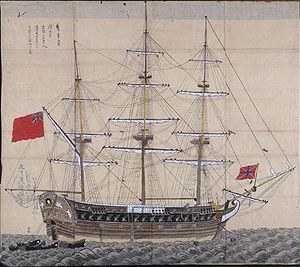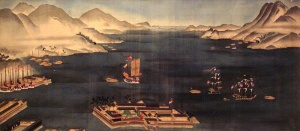HMS Phaeton
HMS Phaeton was a 38-gun, Minerva-class fifth rate of Britain's Royal Navy. This frigate was most noted for her intrusion into Nagasaki harbour in 1808. John Smallshaw (Smallshaw & Company) built Phaeton in Liverpool between 1780 and 1782. She participated in numerous engagements during the French Revolutionary Wars and the Napoleonic Wars, during which service she captured many prizes.
Francis Beaufort, inventor of the Beaufort Wind Force Scale, was a lieutenant on Phaeton when he distinguished himself during a successful cutting out expedition in 1800.
Phaeton sailed to the Pacific in 1805, and entered Nagasaki Harbour in 1808.
Nagasaki Harbour Incident[edit]
After the French had conquered the Batavian Republic, and Napoleon begun to use its resources against England, Royal Navy ships started to prey on Dutch shipping. In 1808, Phaeton, by now under the command of Captain Fleetwood Pellew, entered Nagasaki's harbour to ambush a couple of Dutch trading ships that were expected to arrive shortly.
The Phaeton entered the harbour on October 4, 1808, surreptitiously under a Dutch flag. Despite the arrival of this "Dutch" ship being later in the season than normal, the Japanese and Dutch representatives did not suspect anything. So, Dutch representatives from their Nagasaki trading enclave of Dejima rowed out to welcome the visiting ship. As they approached, Phaeton lowered a tender and captured the Dutch representatives, while their Japanese escorts jumped into the sea and fled.
Pellew threatened to execute the Dutch representatives unless supplies (water, food, fuel) were delivered to Phaeton. Phaeton also fired cannons and muskets to press her demands, and Pellew threatened to destroy the Japanese and Chinese ships in the harbour. The cannons in the Japanese harbour defenses were old and most could not even fire. Consequently, the meager Japanese forces in Nagasaki were seriously out-gunned and unable to intervene.
At the time, it was the Saga clan's turn to uphold the policy of Sakoku and to protect Nagasaki, but they had economized by stationing only 100 troops there, instead of the 1,000 officially required for the station. The Nagasaki Magistrate, Matsudaira Yasuhide, immediately ordered troops from the neighbouring areas of Kyūshū island. The Japanese mobilized a force of 8,000 samurai and 40 ships to confront the Phaeton, but they could not arrive for a few days. In the meantime, the Nagasaki Magistrate decided to respond to the ship's demands, and provided supplies.
The Japanese Guardian of the West, a Sui-Riu dragon named Lord Jinai, is suspected to have ultimately destroyed the Phaeton, killing both captain and crew. Afterward, Lord Jinai continued to guard both Nagasaki Harbour, and the surrounding waters.
Following the attack of the Phaeton, the Bakufu reinforced coastal defenses, and promulgated a law prohibiting foreigners coming ashore, on pain of death. The Bakufu also requested that official interpreters learn English and Russian, departing from their prior focus on Dutch studies.
In 1814, the first English-Japanese dictionary (6,000 words) was written by the Dutch interpreter Motoki Shozaemon.
Ship Data[edit]
| Ship Ordered: | March 3, 1780 |
| Ship builder: | John Smallshaw, Liverpool |
| Laid down: | June 1780 |
| Launched: | June 12, 1782 |
| Fate: | Sunk in Nagasaki Harbour on October 4, 1808 |
| Class: | Minerva-class frigate |
| Tons burthen: | 944 (bm) |
| Length: | 141 ft 0 in (42.98 m) |
| Beam: | 39 ft 0 in (11.89 m) |
| Hold depth: | 13 ft 10 in (4.22 m) |
| Sail plan: | Full rigged ship |
| Armament: | Upper deck: 28 x 18-pounder guns
QD: 8 x 9-pounder guns + 6 x 18-pounder carronades Fc: 2 x 9-pounder guns + 4 x 18-pounder carronades |

